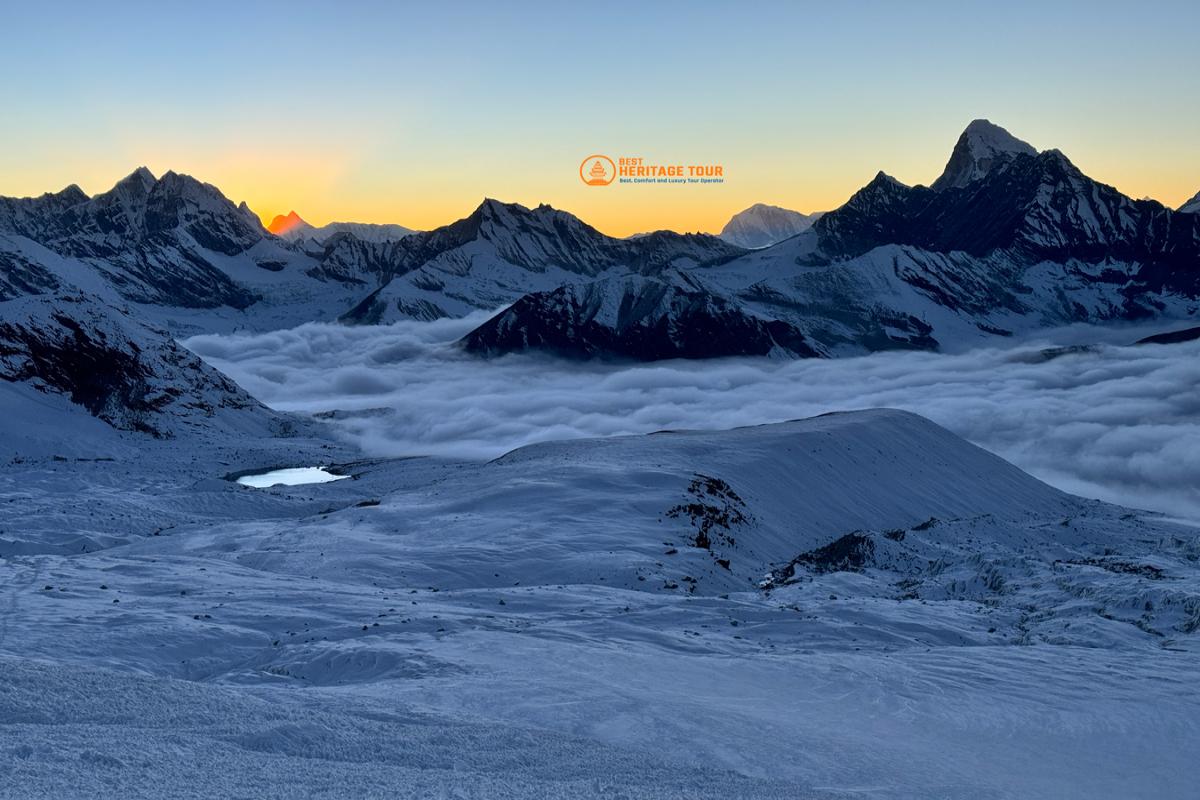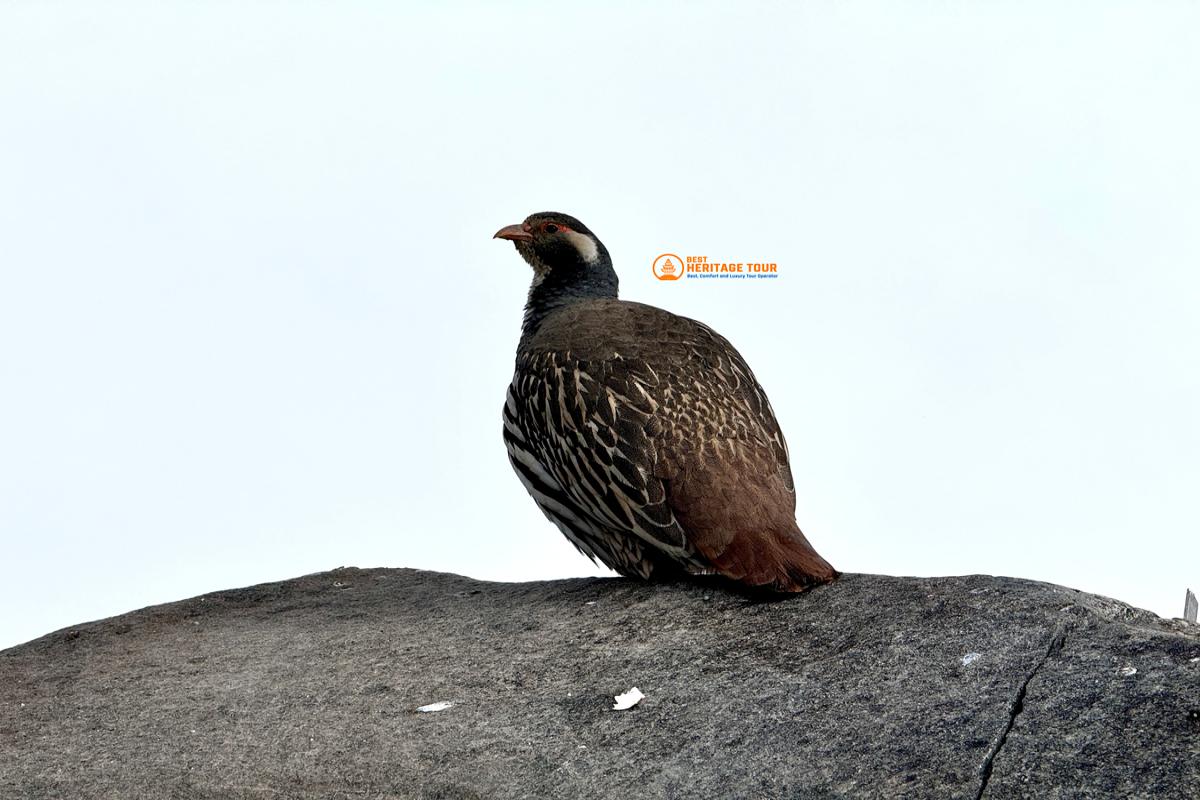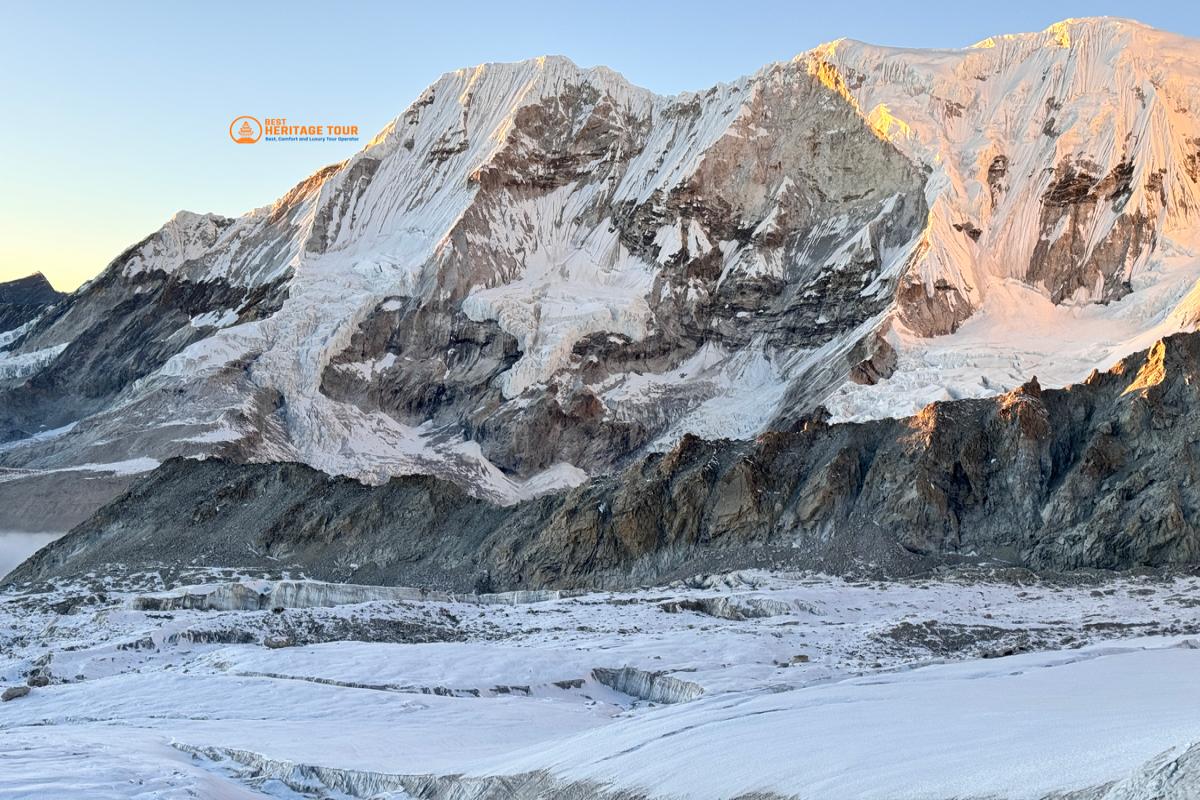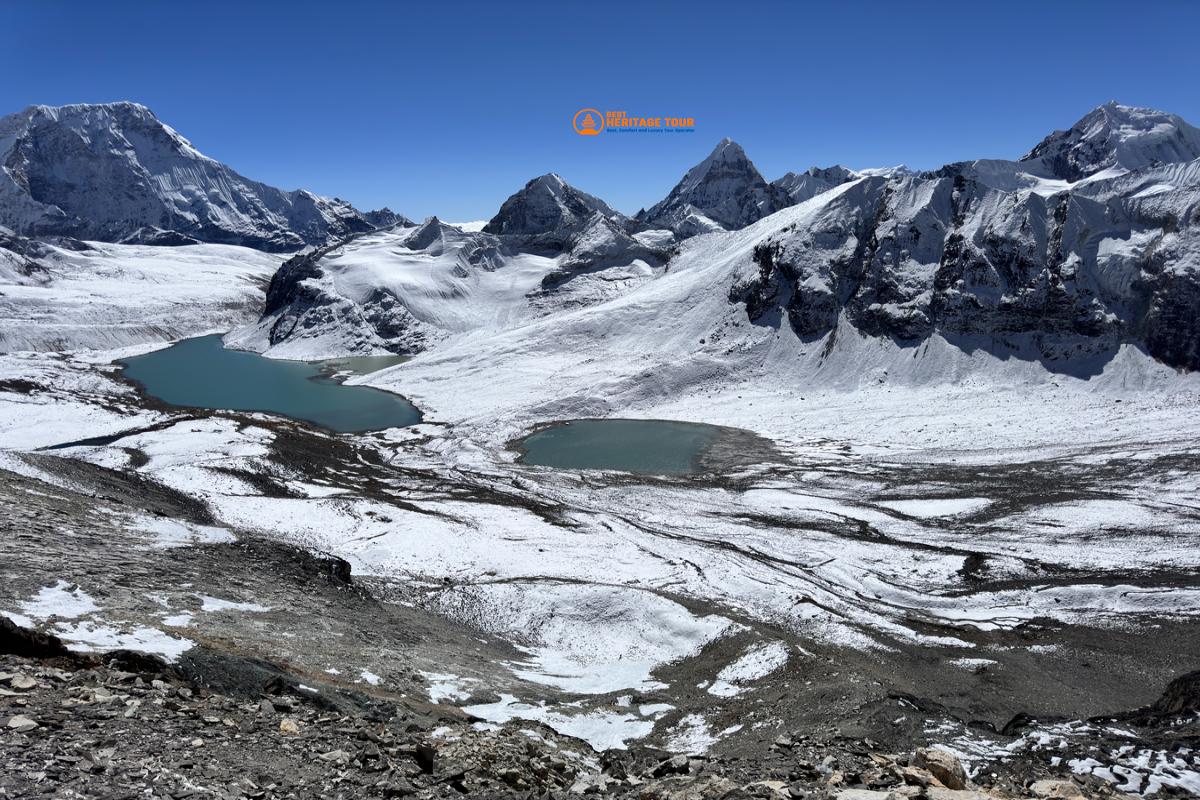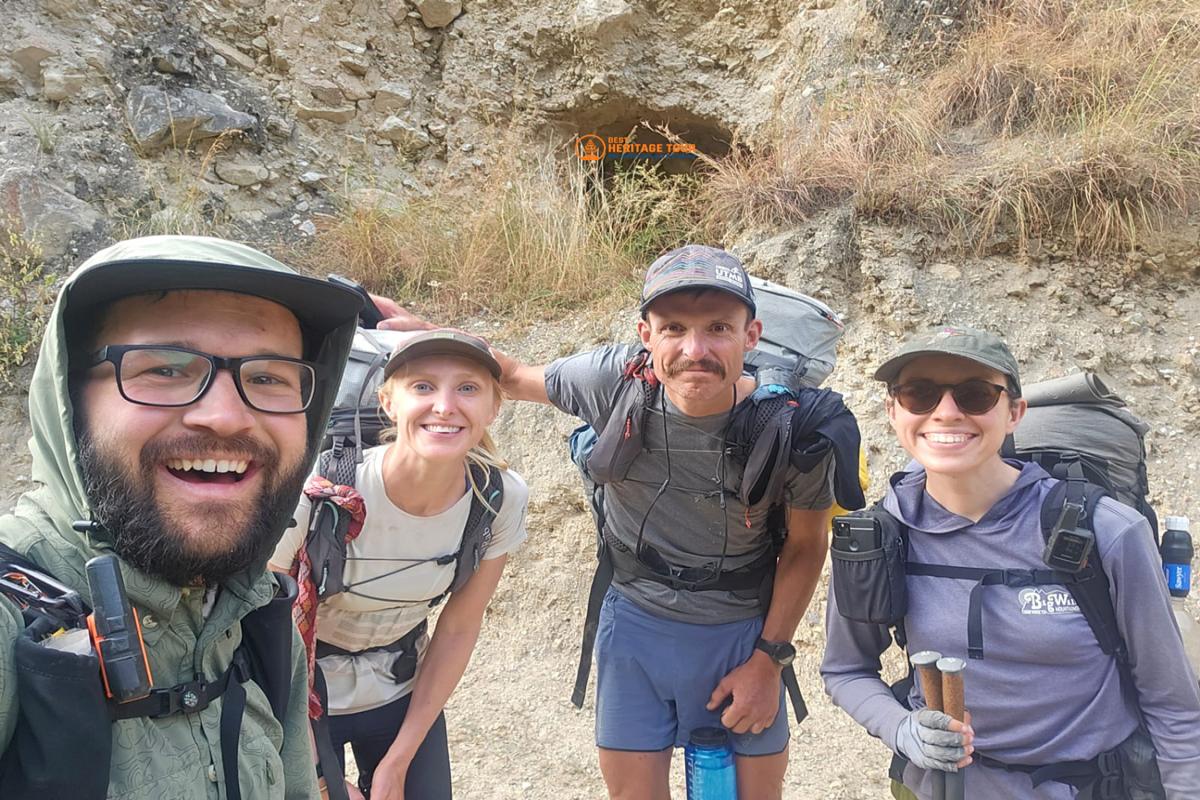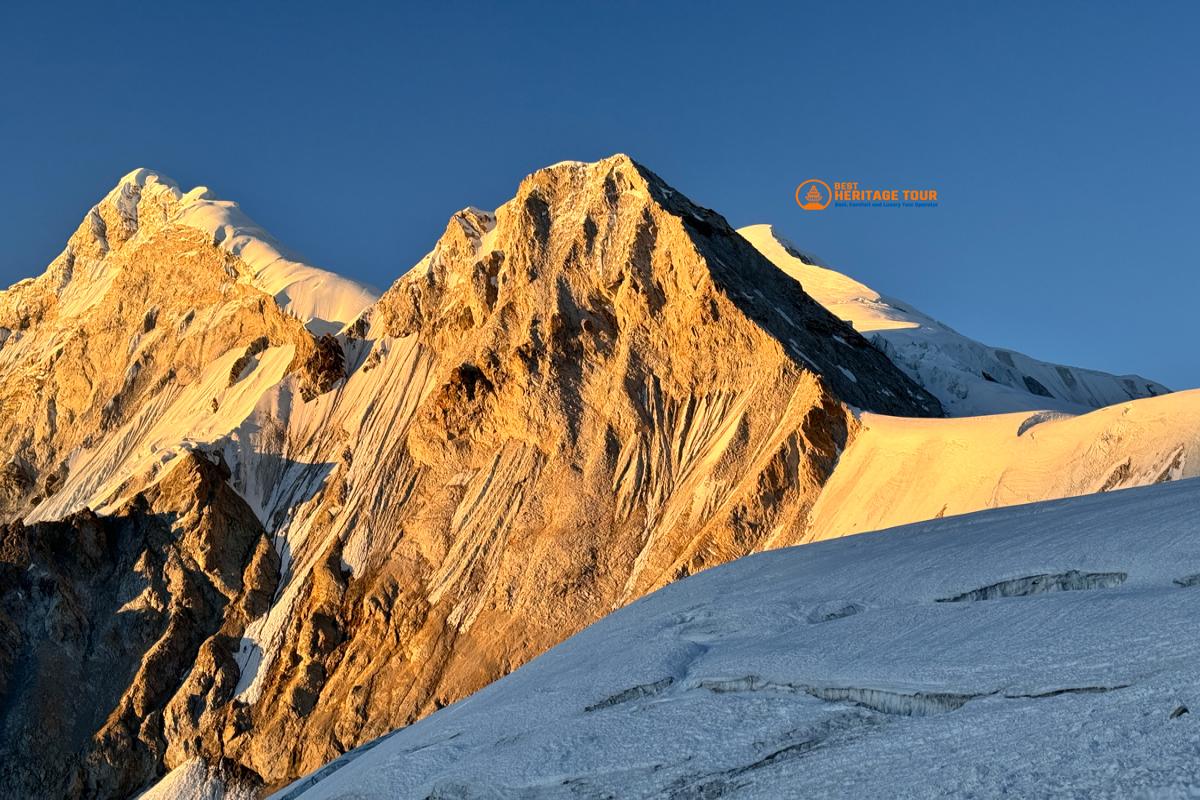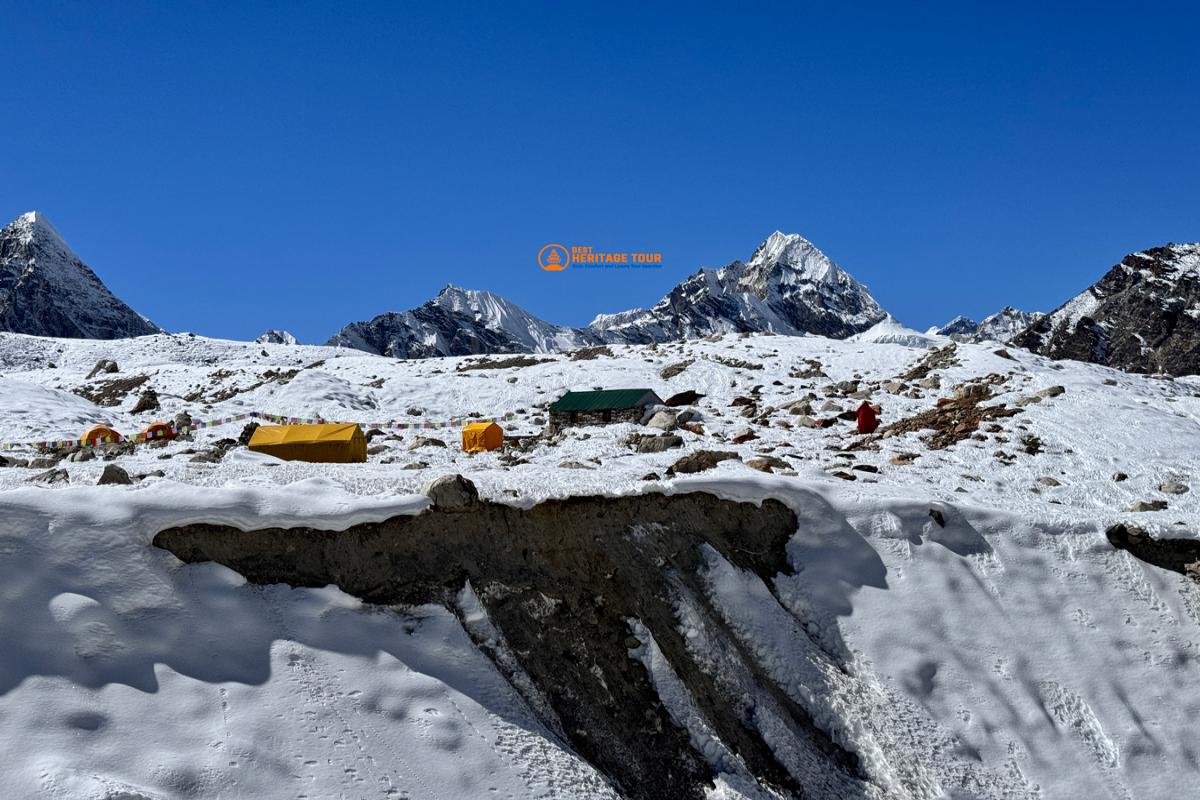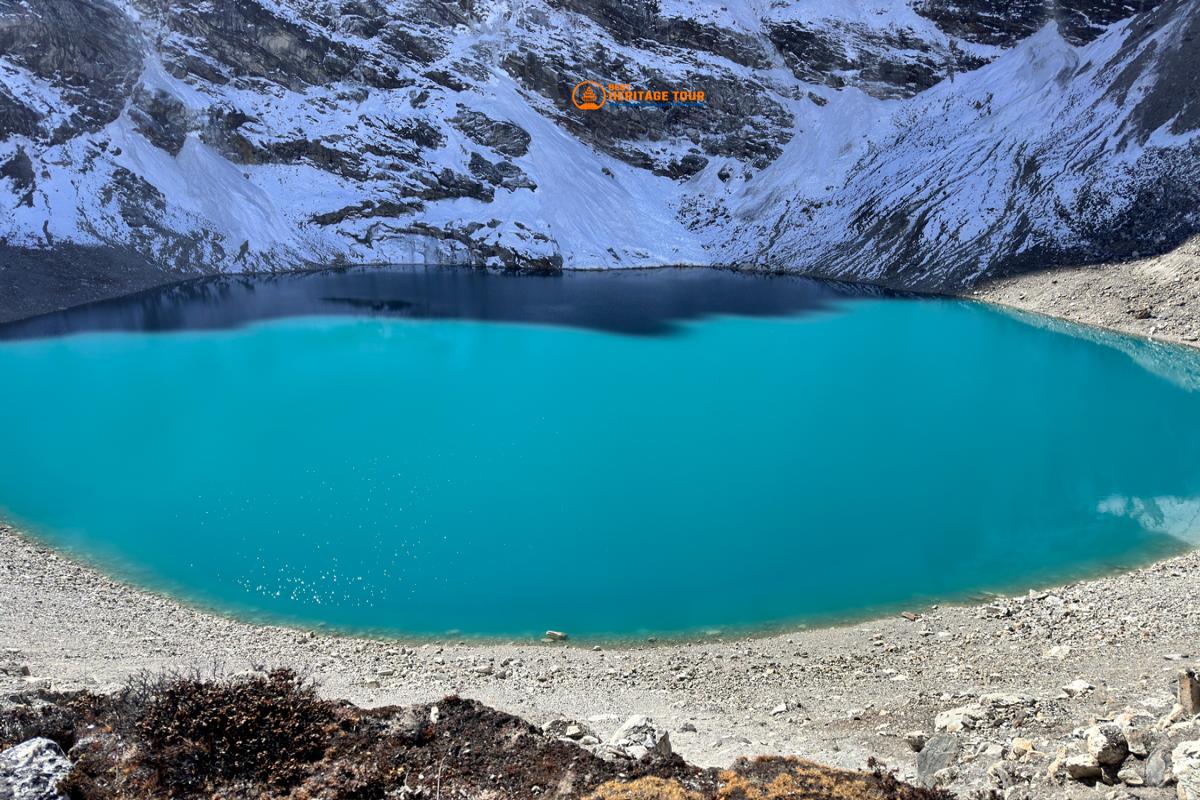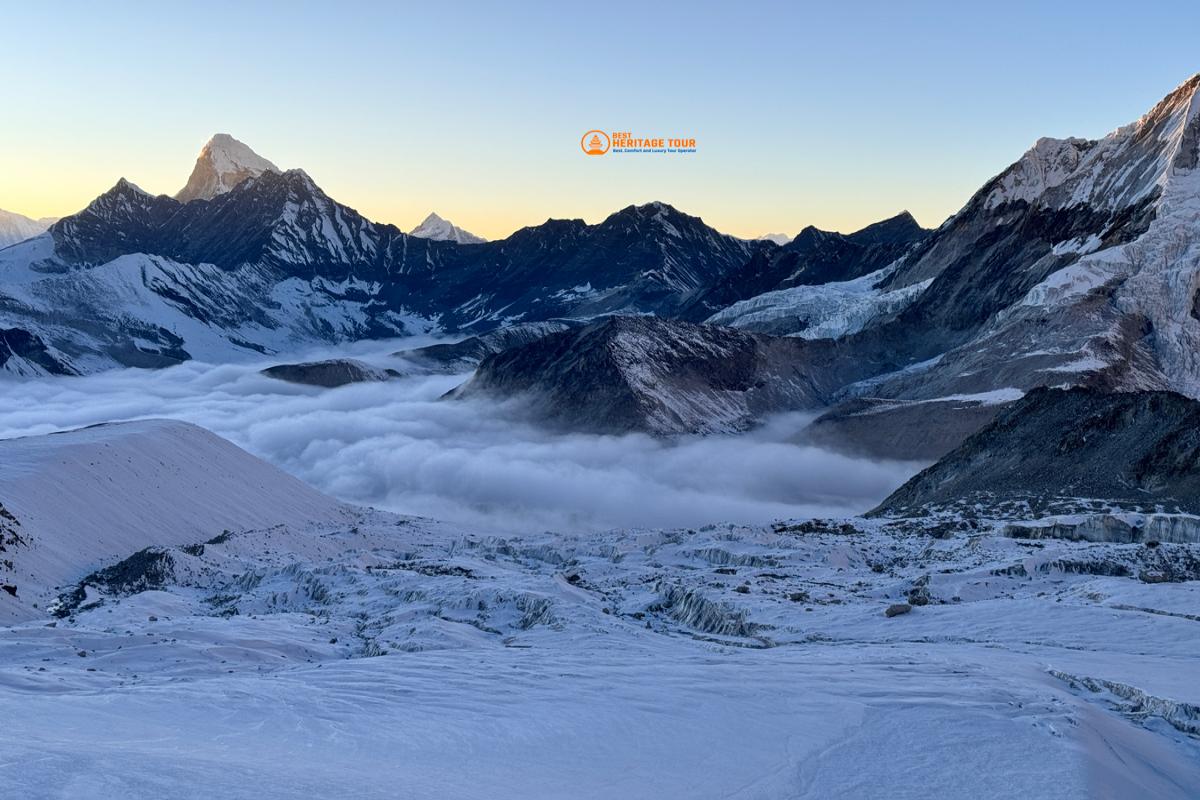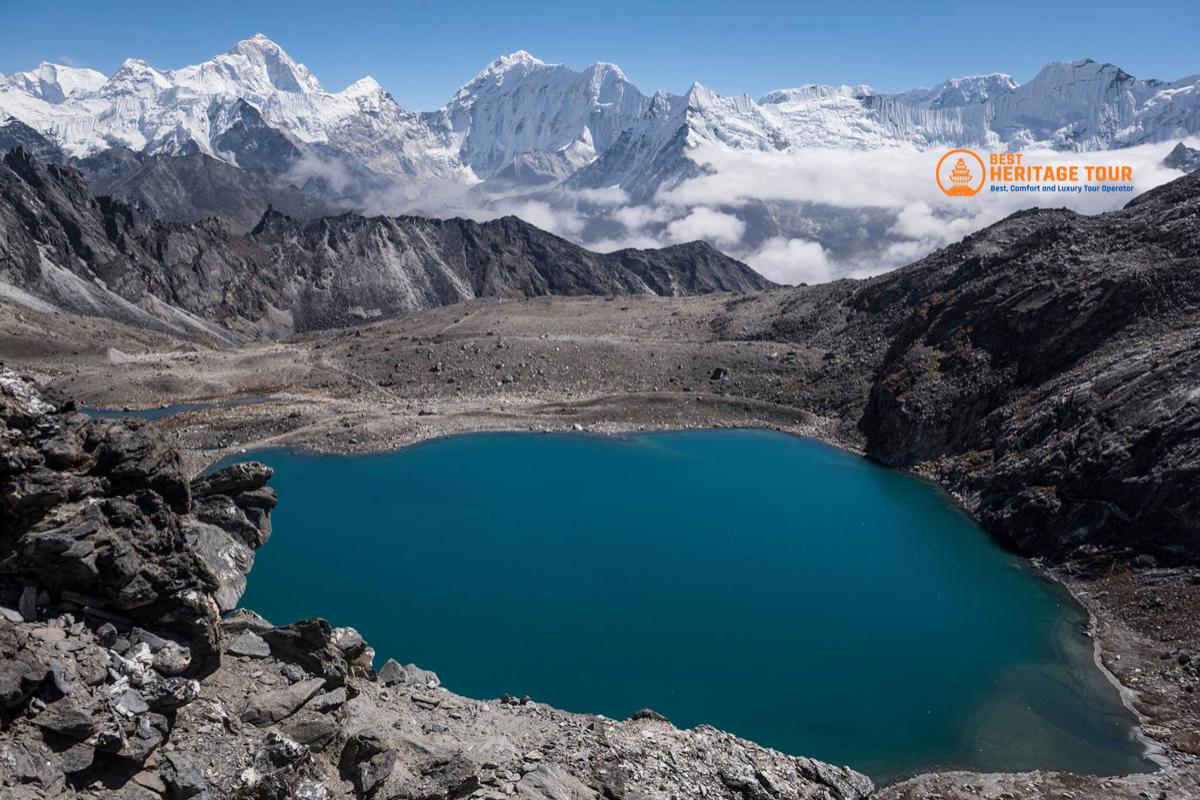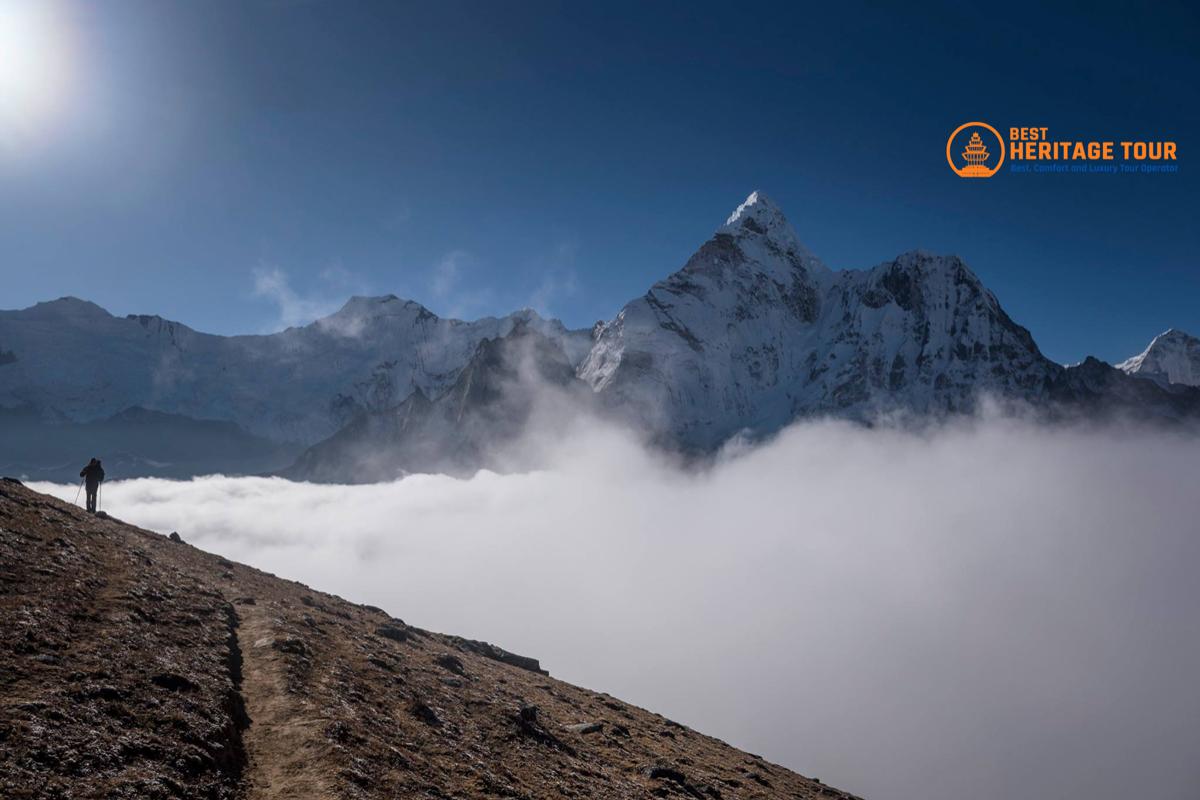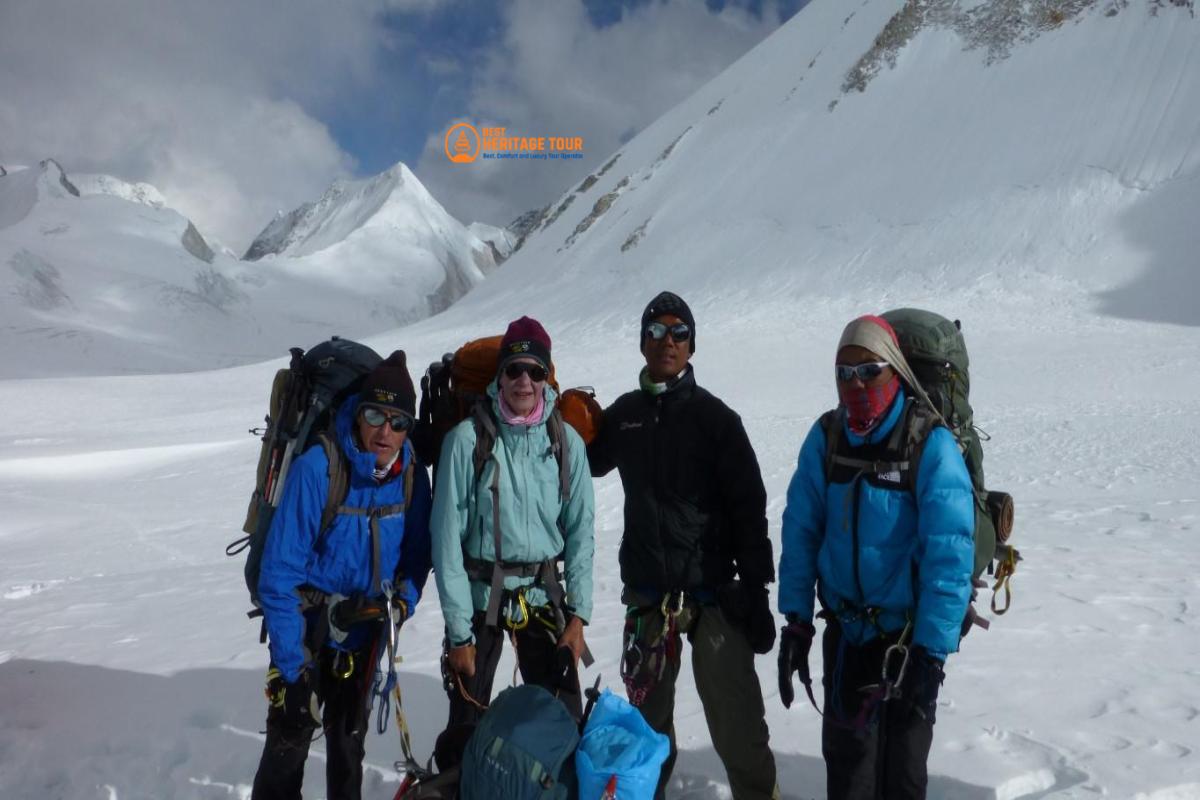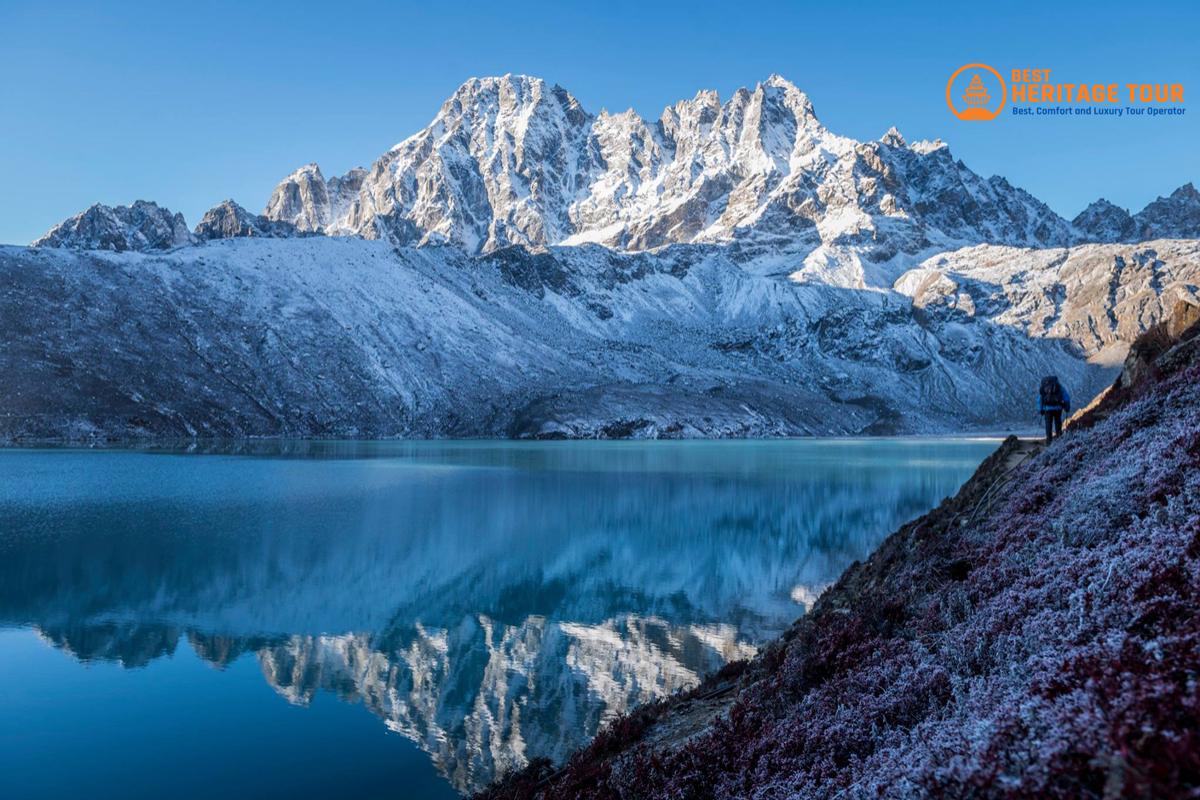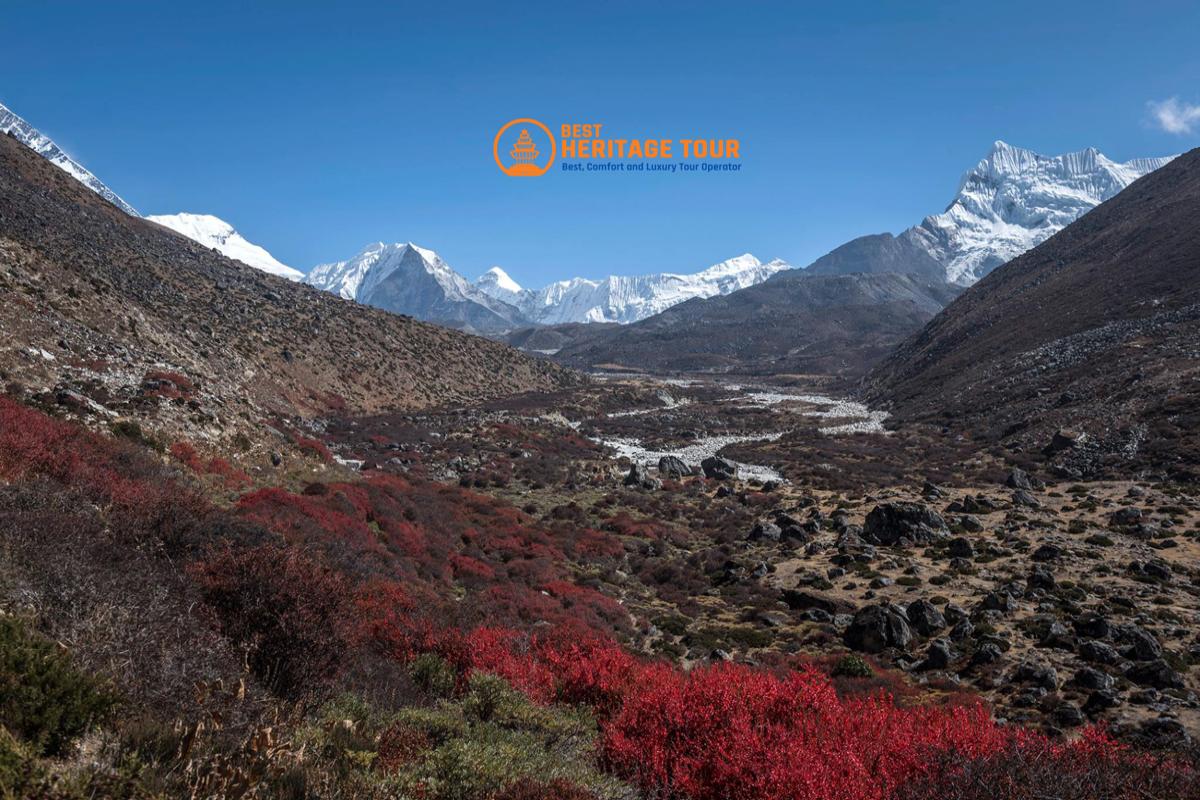Everest Three Pass Trek - 17 Days
Insight on Everest Three Pass Trek
Everest 3 High Pass Trekking is the ultimate trek for thrill seekers and adventurers in the Everest region. This hike not only takes you to the base camp of Mount Everest, but also crosses the three highest passes in the Khumbu region: Kongma La Pass (5,535m), Cho La Pass (5,420m) and Renjo La Pass (5,340m).
Trip at a Glance
Highlights of Everest Three High Pass Trek
- Scenic flight to Lukla
- Mesmerizing mountain views from 3 high passes (Kongma La, Cho La, Lenjo La)
- Famous Sherpa town of Everest region – Namche Bazaar
- Syangboche airport, the highest in Nepal
- Amazing views from Gokyori
- Lake Gokyo
- Old monastery in Tengboche
- UNESCO World Heritage Site
- Prayer wheels, colorful flags, mani stones, high suspension bridges
- Diversity of flora and fauna
- Wildlife like musk deer,Himalayan tahr, colorful pheasants, snow leopards,
- The World's highest glacier which is Khumbu Glacier (4900 m)
- Astonishing panoramic eyeshot from Kala Patthar (5,555 m)
Advantages of Everest Three High Pass Trek with Best Heritage Tour
- Free private Vehicle transfer from airport to hotel on arrival & depature.
- Online trip discussion after booking confirmation
- Blood oxygen saturation will be monitored frequently at high altitude using a pulse oximeter to detect early signs of altitude sickness.
- Medical kit as a preventive measure.
- Easy booking and reservation system
- Communication Channels (email, WhatsApp, Facebook, Viber, Skype, Zoom)
- 24/7 phone contact +9779851149197/+9779810043046
- Simple payment system
- We will provide you with sleeping bags and down jackets if you do not have them
- Free excess baggage storage during the trek
- Duffel bag for porters
Online trip briefing
The online briefing will clear all your doubts about the trek, including what to bring (equipment checklist), itinerary details, and precautions on the trail. After completion of booking, we will notify you by email of the date and time available for the trekking detail, and once we receive the important documents, the briefing about trekking will be conducted online.
Flight information to Lukla
There may be slight changes in the trekking route, especially during peak trekking seasons (March, April, May, October, November), as flights to Lukla depart from Ramechhap/Manthali instead of Kathmandu due to traffic congestion. At other times, flights depart from Kathmandu. To catch a flight from Ramechhap, you will need to leave Kathmandu at around 12:30 am on the day of your scheduled departure and depart for Manthali. The journey will take approximately 5 hours.
Why Everest Three High Pass Trek?
Everest 3 High Pass Trek (or 3 Pass Trek) is one of the most adventurous treks in the world, taking you deep into the Everest region. You will get to know what is around Everest and how the terrain rises to form the tallest mountain in the world. This hike is challenging and gives a closer look at the harsh terrain, cold climate and constant human struggle at high altitude. It covers 103 miles (166 km).
Best Heritage Tour encourages all our valued guests to arrive in Kathmandu as early as possible, at least one day before the trek departure date, to make final preparations. If you miss the online travel meeting, you will still have time to hold a face-to-face meeting. Flights from KTM to Lukla and from Lukla to KTM may be delayed due to weather. In such cases, these flights will be postponed to the next available flight. Therefore, we recommend that you plan at least two additional days as a travel buffer to avoid delays to your international flight to your home country.
Itinerary
The Everest Three Pass Trek will be starts with a flight to the Lukla. During peak trekking seasons (March, April, May, September, October, and November), flights from Kathmandu to Lukla may be diverted via Manthali Airport. To grab an early morning flight to lukla from Manthali, we will picked up you from your hotel at about 12:30 AM and we will take you on a 5-hour drive in vehicle to Manthali Airport. From Manthali airport, it’s takes about a 20-minute flight to Lukla.
You can also rent a helicopter from Kathmandu to Lukla and skip the Kathmandu-Manthali-Lukla route. Assuming the helicopter cost is split between 5 passengers, the cost will be about $550 per person.
In December, January, February, June, July, or August, you'll fly direct from Kathmandu to Lukla. After breakfast, you'll be transferred to Tribhuvan International Airport (TIA) for a 40-minute flight to Lukla's Tenzing-Hillary Airport. After arriving in Lukla, we descend to the Thad Kosi River and cross several suspension bridges to reach Phakding. The hike is short and comfortable, and also allows you to acclimatize to the environment. In Phakding, we visit the local Lemishun Monastery with you.
Start early in the morning from Phakding, walk north along the Dudh Kosi River, passing many suspension bridges including the Hillary Suspension Bridge.
Our route will take you through Monjo village, deep forests and rocky paths to the checkpoint of Sagarmatha National Park, where you will register your permit and climb into the forest. From this forest you will see Mount Everest for the first time. However, you will continue hiking until you reach Namche Bazaar, your destination for the day.
Today is your altitude acclimatization day in Namche. We recommend you take a walk around Namche Bazaar. The town has many cafes, restaurants, souvenir shops and equipment stores with Wi-Fi. Other options include visiting Sagarmatha National Park Visitor Center, traditional Sherpa settlements, Hillary School, Khumjung Monastery and Dingboche Airport.
We will Leave Namche Bazaar, follow the Bhote Kosi via pine and rhododendron forests to Thame. Along the way, you will also see the clay-stucco stupa of Pulte. Further on you will reach Tamo and Tamo Gompa, from where the road descends steeply to the Khumbu Hydroelectric Power Plant and finally to Thame at the edge of the Khumbu Valley. Thame is home to many famous Sherpa climbers, including Apa Sherpa, who holds the world record for summiting Everest 21 times. Tenzing Norgay Sherpa along with Edmund Hillary, one of the first men to summit Everest, also grew up here.
This day, you will hike through villages, enjoying the countryside, vegetation and mountain views. In the bright morning, the brightly colored rocks, lichens, yaks and snow-capped mountains seem to come alive. The last village in the valley is Tharanga, but you will continue hiking through Malurung village (4200m) and finally reach Lundeng, your destination for the day. During your free time, you can visit Nakpa Valley, once an ancient trade route to Tibet. You can also hike to Chor Lermo Lake.
This day will be your most exciting day as you cross Lenjola Pass, the first pass on the route. Leaving Ryuden behind, we continue our journey towards the Lake Gokyo area, where depending on the season you can see various human activities, including yak huts. Once you reach Renjo La Pass, you can enjoy magnificent views of high peaks such as Mt. Everest (8848m), Mt. Lhotse (8516m), Mt. Makalu (8463m) and Mt. Cho Oyu (8201m). You will also see the third major Gokyo lake (out of five), Dudh Pokhari. Gokyo village is located above this lake. The track will then descends and enters the Gokyo Valley, but we need to be careful as the trail where we will may be icy.
Acclimatizing to the altitude will give you time to ascend to the Gokyo Ri Viewpoint, from where you can enjoy mesmerizing views of the Everest region, including the Sonak Tso and Ngozma Tso lakes. 3 km north of Gokyo is Ngozumpa Tso Glacier (5,000 m) and a 5-minute walk will take you to Scoundrel's Viewpoint, which offers spectacular views of Cho Oyu, Everest, Lhotse, Nuptse and Makalu.
To the north of Gokyo Lake 5 there are breathtaking views of Cho Oyu Base Camp and Ngozumpa Glacier, the longest glacier in the Himalayas.
This day we return to hiking and hike across the Ngozumpa Glacier, but the path is rocky and involves some ups and downs. As we hike down the valley along the eastern glacial deposits, breathtaking views open up and encourage us to continue further. Eventually you will reach a group of lodges known as Tangnak. This place is in a tranquil environment and ideally located for crossing the Chola High Pass.
Today we have a more challenging trek planned where we will hike through rocky paths and glacial deposits before finally reaching Dzongla. But the most exciting part will be crossing the Chola Pass (5420 m), which connects Dzongla to Tangnak. This pass offers amazing views of Everest and other Himalayan ranges. After enjoying the view from there, descend to Dzongla where you will spend the night.
After a night in Dzongla, we wake up the next day and continue our trek. Today's destination is Lobuche, where we return to the classic Everest Base Camp trek. But first we start the day by descending along the moraine to Cho La Lake. On the way, we see a memorial to climbers who died in the area. The hike to Lobuche is enjoyable. You will reach Lobuche by following the trails of Imja Khola Valley.
You finally reach Everest Base Camp. The hike starts with a hike through the moraine next to the Khumbu Glacier until you reach Gorak Shep.You have to Leave your bags at Gorak Shep and have to climb north to the Mount Everest Base Camp. The camp itself will be the base for climbers ascending and descending Everest.
Reaching Everest Base Camp (EBC) is not an easy feat. Reaching EBC shows how determined you are. In a way, it is a victory over yourself, a victory of determination, positivity and perseverance. We intend to stay at EBC for a while and enjoy the amazing views that are rarely seen on earth. After taking a few photos, we will descend to Gorakshep and spend the night there.
The previous day we were at the base camp of Mt. Everest, but even upon reaching the base camp we could not see much of Mt. Everest. Therefore, this day provides an opportunity to see Everest up close in all its glory.
To witness the dawn of Everest, we wake up early in the morning and trek to Kala Patthar (5,555 m), a famous lookout point of Everest. We stay at Kala Patthar for a while to enjoy the sunrise from Everest, then descend to Gorakshep for breakfast. After breakfast, return to your destination for the day - Lobuche.
During this time we will cross the last of the three passes whole on the way. This pass is considered the most difficult of the three. The hike starts from Lobuche. Climbing to Kongma La Pass is very much easy. The path is dotted with frozen lakes and mummified cranes mark the pass. From the pass you can see Lhotse, Lhotse Shal, Makalu, Baruntse and Ana Dablam. We went down from Kongma La Pass into the easternpart of the Nyigyan Khola Valley and reach the village of Chhukung. Sherpas use the area for yak grazing, but there are no permanent settlements. Recently, the area has become more popular as a trekking peak, and trekkers often use Chhukung for altitude acclimatization.
We continue our path by descending the Imja Khola Valley and passing through the village of Dingboche, known for its stone-walled potato fields and mountain pastures. Along the way you will also see the kalkas (highland huts) of Tura, Orsho and Shomare. Continuing the trek, you will reach the villages of Pangboche, the year-round habitation in the valley, and then to the Tengboche. From the viewpoint in Tengboche you will be able to enjoy breathtaking views of impressive peaks such as Ama Dablam (6856m), Everest (8848m), Nuptse (7861m) and Lhotse (8501m). You will also visit Tengboche Gompa, the oldest monastery in the Khumbu region.
The road to Namche Bazaar passes through forests inhabited by highland fauna such as pheasants, musk deer, mountain goats and even snow leopards. It climbs steep slopes lined with chortens and hanging prayer flags. From the trail you can enjoy views of Everest's summit and the backside of Lhotse.
The last day of the trek will takes you back to the Lukla. After breakfast, we hike up the steep path that leads to the Hillary Suspension Bridge. But we continue hiking through several villages in the Dudh Kosi River Valley until we reach Lukla. Trekking Day 16, the trekking is almost over. I hope you really enjoyed the whole hike.
If all Schedule goes as a plan, you will came back to Kathmandu on this very day. Depending on the trekking season, you will fly to Manthali or Kathmandu. If your trek is in March, April, May, September, October or November, you will probably fly to Manthali and then drive to Kathmandu. In other months (December, January, February, June, July and August), there are direct flights from Lukla to Kathmandu.
To avoid the Lukla-Manthali-Kathmandu route, team up with 4 other people and book a helicopter. This will cost an additional fee of approximately $550 per person.
We hope your trek will leave you feeling relaxed and reflecting on your time spent in the Everest region. We will organise a farewell party on this day.
What is included?
- Domestic flight (Kathmandu – Lukla – Kathmandu), airfare, airport departure tax
- 16 nights in total (Lukla, Phakding, Namche (3N), 5 nights in ensuite rooms, Thame, Lundeng, Gokyo (2N), Dzongla, Lobuche (2N), 11 nights in standard rooms in Chukung, Gorakshep, Thangnak, Pheriche).
- All standard meals during the hike (17 lunches, 16 dinners, 17 breakfasts).
- Experienced English-speaking trekking guides with national certification from Best Heritage Tours (minimum 12 hikers: 1 assistant guide)
- Carriers to carry the climbers' luggage. 1 carrier for 2 hikers. Maximum weight limit per wearer is 18kg. Luggage limit per climber is 9kg. Guide and porter compensation – food, insurance, salary, accommodation, transportation, air tickets, necessary equipment
- Water purification tablets for clean drinking water
- Sagarmatha National Park entry permit fee
- Khumbu Pashan Lhamu local government fees
- Daily snacks (cookies) and fresh seasonal fruits
- Souvenir – Best Heritage Tours T-shirt and cap
- Receive a Best Heritage Tour Appreciation Certificate upon successful completion of the trek
- Farewell dinner at the end of the hike
What is not included?
- International flight tickets
- Nepalese multiple entry visa fee upon arrival at Tribhuvan International Airport (15 days: $25-30, 30 days: $40-50, 90 days: $100-110)
- Excess baggage fee (limit: 9kg per person)
- All food and accommodation in Kathmandu before & after the journey
- Earlier arrival or later departure, or earlier return from the trek will result in an additional night stay in Kathmandu.
- Personal expenses (groceries, snacks, hot water bottles, hot (tea, coffee) and cold drinks, hot showers, alcohol, Wi-Fi, phone, battery charging fees), additional porters, etc.
- Personal clothing and equipment
- Travel insurance covering emergency rescue and evacuation at height (mandatory)
- Tips for tour guides and porters
- Additional expenses due to delays caused by events beyond our control such as landslides, weather conditions, changes in itinerary due to safety concerns, illness, changes in government policies, strikes, etc.
- All government taxes 13%, SSF, and 10% service charges
Route Map
Review
An Unforgettable Adventure with Best Heritage Tour
I had done Everest Three pass trek with Best Heritage Tour and it was one of the most adventurous and challenging treks I had ever done in my life. I was in a group of other 7...
View DetailChallenging Yet Rewarding Trek
I personally come in touch with Mr. Anil Dhakal- the founder of the Best Heritage Tour. He was very sociable and ensured that everything during the trek was perfect for us.As soon...
View DetailThree Pass trek itself was challenging but absolutely amazing and worth it. Crossing the Cho La Pass was tough. I still remember how I was struggling crossing the icy section but...
View DetailFAQ's
Yes, all our guides are fluent in English and many speak other languages. This facilitates clear communication and enhances your overall experience.
Most trekking guides in Nepal speak basic to advanced English, which is enough for general communication about trekking and safety precautions. Some speak more fluent English, which will improve your overall trekking experience.
Yes, most visitors need a tourist visa to enter Nepal. A visa can be obtained on arrival at Tribhuvan International Airport in Kathmandu or applied for in advance at a Nepalese embassy or consulate.
Yes, you will need two passport-sized photos for both the visa application and the trekking permits, so it's a good idea to bring extra copies just in case.
You'll need a valid passport (with at least six months validity), a passport-sized photo, and the visa fee (which varies depending on the duration of stay).
To obtain the RAP, you’ll need:
- A valid passport.
- A Nepal visa.
- Travel insurance.
- Two passport-sized photos.
- A letter from your trekking agency detailing your itinerary and the names of the guide and group.
Yes, it’s possible to extend your visa if you wish to stay longer in Nepal. Extensions can be processed at the Department of Immigration in Kathmandu or Pokhara, but you should apply before your current visa expires.
You can exchange US dollars or Euros for Nepalese rupees upon arrival, but we recommend carrying cash in the local currency for most transactions outside of major cities.
Facilities may vary, but most teahouses offer the following:
- Basic bedding (mattress, pillow).
- A dining area for eating meals.
- Charging options for electronic devices (usually for a fee).
- Limited Wi-Fi access.
Hygiene standards may vary. Most teahouses strive for cleanliness, but it is wise to temper your expectations, especially in remote areas.
Yes, teahouses are generally safe and many hikers have had good experiences with them, but it's wise to use common sense, lock up your valuables, and choose a reputable establishment recommended by your guide.
To ensure you are comfortable while trekking, your backpack should ideally weigh 10-15% of your body weight, usually around 10-15 kg (22-33 lbs).
Physical preparation is essential to a successful trekking experience. Begin an exercise program 6-8 weeks before your hike that focuses on:
- Aerobic exercise: Activities such as running, cycling, and swimming to improve endurance.
- Strength training: Leg, core, and upper body exercises to increase strength.
- Practice hiking: Fill up your backpack and go on a short hike to simulate trekking conditions.
Hiring porters is not mandatory but highly recommended. Carriers allow you to carry heavy loads and make the hike more comfortable. This also supports the local economy and creates jobs in the area.
It is important to stay hydrated while climbing. Bring a reusable water bottle and use water purification tablets or a filter if necessary. Pack energy-rich snacks such as nuts, energy bars and dried fruit to maintain your energy levels throughout the day.
Before any hike, test your equipment on a training hike to make sure everything fits well and works properly. Ensure that you break in your trekking footwear to prevent blisters and discomfort.
Yes, we recommend that you have a small first aid kit with some basic items such as adhesive tape, disinfectant wipes, painkillers, altitude sickness medication, and personal medications.
Yes, you can rent trekking gear in Kathmandu and other major cities. However, we recommend that you check the quality and suitability of the equipment before renting.
Acclimatization helps your body adapt to high altitudes and reduces the risk of altitude sickness. Gradual ascents and rest days are essential to acclimatize effectively.
Pay attention to your body's signals, especially when fatigue sets in.
- Take a break: Take a break when necessary and find a comfortable place to sit and relax.
- Stay hydrated: Drink water regularly and eat snacks to replenish your energy.
- Inform your tour guide: Should you begin to feel unwell, it is important to communicate this to your tour guide. They can assist in modifying the pace and itinerary as needed.
Training at altitude helps your body adapt to lower oxygen levels, which can be beneficial for hiking. However, it is not absolutely necessary. Being in good cardiovascular condition can also prepare you for the conditions.
In the event of altitude sickness, it is vital to descend to a lower elevation immediately and take time to rest. Drinking plenty of fluids and taking over-the-counter medications (such as ibuprofen) can help reduce symptoms. See a doctor if symptoms persist.
Consult your doctor for individual vaccination recommendations. Common vaccinations climbers should consider include:
- Tetanus
- Hepatitis A and B
- Typhoid
- Rabies (if in contact with wild animals)
The main health risks while trekking include:
- Altitude sickness: occurs when you ascend too quickly without adequate acclimatization, causing symptoms like headaches, nausea, and fatigue.
- Dehydration: Insufficient fluid intake can cause fatigue and headaches.
- Injuries: Falls and slips on uneven surfaces can cause sprains and fractures.
Trekkers are strongly encouraged to take out travel insurance. Make sure your insurance covers high altitude hiking, medical evacuation and trip cancellation. This gives you peace of mind and financial protection in case of emergencies or unexpected events.
In case of emergency:
- Keep calm: Staying calm helps you make better choices.
- Contact your tour guides. They are trained to deal with emergencies and know what is best.
- Use communication devices: If necessary, you can use satellite phones and emergency transmitters for communication in remote areas.
In remote and secluded areas, maintaining a sense of connection can prove to be quite challenging.
- Cellular Network: Most areas along the trek have good mobile coverage, especially in larger villages such as Samagaon. However, signals can be unreliable.
- Wi-Fi Availability: Some teahouses offer Wi-Fi, but the connection can be slow and there may be a charge.
- Satellite Phone: If traveling to an area without cell coverage, consider renting a satellite phone in case of emergency.
Yes, Nepal offers an electronic visa (e-visa) that can be applied for online before arriving. This process enables you to bypass the visa queue upon arrival at the airport. After completing the online application, you can get your visa stamped on arrival.
The tourist visa fees are as follows:
• 15 days: USD 30
• 30 days: USD 50
• 90 days: USD 125 Note that these fees are subject to change, so check the current visa fees before your trip.
No, previous trekking experience is not mandatory. However, a good level of physical fitness is necessary, as the trek involves walking for 5-7 hours per day and ascending to high altitudes.
Most teahouses in remote areas do not allow online reservations. However, during peak seasons, guides or trekking agencies can help secure rooms in advance. It’s recommended to have a guide manage accommodations, especially in crowded seasons.
Yes, teahouses usually provide blankets, but they may not always be warm enough at high altitudes. Bringing your own sleeping bag rated for cold weather is essential.
Yes, it's recommended to bring your own trekking poles. They provide essential support during steep ascents and descents, and are particularly helpful for managing balance on rough terrain.
You should bring sturdy, waterproof trekking boots with good ankle support. Ensure they are well broken-in before the trek to avoid blisters or discomfort.
Start a fitness routine several months before the trek to gradually build strength and endurance. Even light to moderate exercise a few times a week can help condition your body. You can also opt for shorter and easier treks first to gain experience.
Yes, waterborne diseases are a concern in remote areas. Always drink purified or boiled water. Bring water purification tablets or a portable water filter to treat water from local sources.
Yes, if you wish to extend your stay, you can apply for a visa extension at the immigration office in Kathmandu or Pokhara.
While Nepali is the primary language, most staff members in lodges speak English, and some may even speak other languages. Communication should not be an issue for international tourists.
This trek is considered moderate, with gentle ascents and shorter daily hikes. No technical climbing is involved, making it suitable for a wide range of fitness levels.
It’s advisable to be up-to-date on routine vaccinations, including hepatitis A and typhoid. Talk to your doctor about the vaccinations you need for Nepal.
While basic medical services can be found in larger villages such as Namche Bazaar, serious health concerns may require helicopter evacuation.
Hot showers are available in some teahouses for an extra fee, but Wi-Fi is scarce and often comes with additional costs.
- Cardio: Running, swimming, or cycling 3-4 times a week can improve endurance.
- Leg Strength: Include exercises like squats, lunges, and hiking on hilly terrain to prepare your legs for the varied elevation gains.
- Endurance: Long walks with a backpack, gradually increasing your distance and weight, will help your body adjust to carrying a load for extended periods.
Always check travel advisories from your government and the local situation before planning your trip. Nepal is generally safe for tourists, but it's wise to stay informed about political and environmental conditions.
Choosing the best heritage tour provides an enriching cultural experience, blending education, comfort, and unique local interactions for unforgettable travel memories.
The majority of international flights arrive at Tribhuvan International Airport, which is located in Kathmandu. From this location, travelers can connect to Lukla to commence their trekking journey.
You typically need a valid passport, a completed visa application form, and a passport-sized photo. Payment can be made in cash or via card at the airport.
Yes, tourist visas are eligible for extension at the Department of Immigration located in Kathmandu. Ensure you have a valid reason and required documents for the extension.
If you wish to extend your stay in Nepal beyond your visa’s initial duration, you can do so by applying at the Department of Immigration in Kathmandu. Extensions are available for a maximum of 30 days, and it’s recommended to apply before your current visa expires. Best Heritage Tour can help you with the extension process if required during your Australian Camp Trek.

